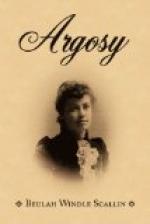Early in the year 188—, I was appointed Precentor of this cathedral, and in the course of duty was brought much in contact with Dr. F., the organist.
It was my custom frequently, after service, to join him in the organ-loft and to discuss various matters of interest connected with our own church and the outside world. He was a most charming companion; a first-rate organist and master of theory, and a man of large experience and great general culture.
One morning, soon after my appointment, I joined Dr. F. with a special purpose in view.
We had met to discuss the music for the approaching festival of Easter. The Doctor was in his shirt-sleeves, standing in the interior of the organ, covered with cobwebs and dirt, inspecting the woodwork, which was getting into a very ruinous condition, and endeavouring to replace a pipe which had fallen from its proper position so as to interfere with many of its neighbours.
“Here’s a nice state of things,” said he, ruefully regarding his surroundings. “If we don’t have something done soon the whole organ will fall to pieces; and I am so afraid, lest in re-modelling it, the tone of these matchless diapasons will be affected. There is nothing like them anywhere in England. We must have it done soon, however; I only hope we may gain more than we lose.”
It was indeed time something was done. The key-boards of the old organ were yellow and uneven with age. They reminded one of steps hollowed by the knees of pilgrims, they were so scooped out by the fingers of past generations of organists. Its stops were of all shapes and sizes, and their character was indicated by paper labels gummed underneath. It had been built about the year 1670 by Renatus Harris and, although added to on several occasions, the original work still remained. Being placed on a screen between the nave and the choir, it occupied an unrivalled position for sound.
After awhile Dr. F. succeeded in putting matters a little to rights and, seated at the key-boards, proceeded to play upon the diapasons, the tone of which he had so extolled. It would really be impossible to exaggerate the solemnity, the richness, and the indescribable sadness of the sounds which proceeded from them; one never hears anything like it in modern organs. These have their advantages and their peculiar effects, but they lack that mellowed richness of tone which seems an art belonging to the builders of the past.
Presently the Doctor ceased, and producing a roll of music told me it was a Service he was accustomed to have each Easter, and asked me to listen and say what I thought of it.
It would be impossible for me to express in words the admiration I felt on hearing it. It was a most masterly composition, and was moreover entirely original and unlike the writing of any known composer. It possessed an individuality which distinguished it from every other work of a like nature. All one could say with certainty about it was that it was not modern music. There was a simplicity and a severity about it which stamped it unmistakably as belonging to an age anterior even to Bach or Handel: modern writers employ more ornamentation and are not so restricted in their harmonies; modern art sanctions a greater liberty, a less simplicity of method, and a less rigid conformity to rule.




